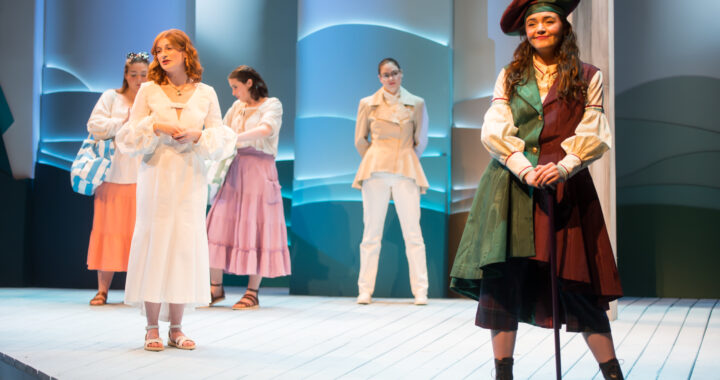'The Hunger Games': A Cinematic Feast
4 min readWarning: Attempt to read property "post_excerpt" on null in /home/bgonline/public_html/wp-content/themes/newsphere-pro/inc/hooks/hook-single-header.php on line 65
If nothing else, “The Hunger Games” proves one thing: there are some things one simply cannot do with words on paper that one can do with film.
Based on the first book in Suzanne Collins’ popular young adult “Hunger Games” trilogy, “The Hunger Games” as a movie can stand by itself. Unlike some movies based upon books, it makes sense on its own and should not be compared to the book on which it was based. Sure it is similar, but it is its own piece of art and should be seen as such.
The basis of “The Hunger Games” is simple: sometime in the future, in Panem, located in the area that used to be America, there has been a war between the citizens and the government. The government, located in an area known as The Capitol, has prevailed and the rest of the country, split into 12 regions called Districts, has been punished. Every year each of the 12 Districts has to send both a young male and female tribute to “The Hunger Games,” a battle to the death from which only one of the 24 tributes will emerge alive, to pay for their rebellion. The games are much like a brutal version of “Survivor” and are required viewing for all residents of Panem.
Despite the graphic premise, the violence is rather toned down. There are deaths, but the way they are shown, in various quick cuts, is more artistic than gory; no one is shown bleeding to death and some die bloodlessly.
Though violence and death are important to “The Hunger Games,” the story is not just about death. It has many elements, from a little bit of a love story to comedic bits and will have you hooked throughout the entire 162-minute movie.
The movie is gorgeous and full of amazing cinematography. The contrast between the dusty, gritty world of District 12 and the rich, flamboyant world of The Capitol shows the dystopia in which “The Hunger Games” is set.
This contrast is also shown through the costuming, with The Capitol’s citizens seen dressed in bright vibrant colors with lots of accessories and things that sparkle in contrast with those who come from the 12 Districts whose clothes are muted, in shades of blue, gray, brown and white for the most part and are simple, unadorned pieces that can be worked in.
Some scenes, like the one involving the Tracker Jackers, mutated wasps created by The Capitol during the war, are both brilliant and terrifying at the same time. They truly show how cruel the Capitol is, as well as showing how certain aspects of the story can be portrayed on film much better than they can be written in a book.
Along with the visuals, the acting stands out. Jennifer Lawrence, known for her award-winning performance in 2010’s “Winter’s Bone,” stands out as Katniss Everdeen, the heroine of the story and the female tribute from District 12. Lawrence shines as “The Girl On Fire,” as Katniss is referred to in the movie several times, in contrast to her costar, Josh Hutcherson, who plays Peeta Mellark, the male tribute from District 12, who fails to make much of an impression, despite his character’s integral role in the story. Hutcherson proves to be little more than a pretty face on screen.
Stealing some scenes in the film are Stanley Tucci who plays Caesar Flickerman, The Capitol’s answer to Ryan Seacrest, who interviews the Tributes before the games begin, introducing them to the audience as well as providing commentary throughout the games. With unnaturally bright blue hair, a matching sparkly blue suit and an exaggerated laugh, Tucci embodies Flickerman perfectly, making him both likable to the audience while giving off an air of fakeness at the same time.
Wes Bentley also stands out as game-maker Seneca Crane. With his flame like beard and cold, calculated ways, he clashes with President Snow, the elderly yet cruel president of the Capitol played by Donald Sutherland.
Although the movie is a great piece and can stand on its own, there are some things that may confuse those who are not familiar with the book upon which “The Hunger Games” is based. The most noticeable error may be concerning Effie Trinket, the escort from the Capitol for the District 12 tributes. Effie, despite showing up in many scenes and being integral to the plot, especially in the first half of the movie, is never mentioned by name in the movie, leaving those unfamiliar with the story to wonder who she is.
The significance of the Mockingjay and how it came to be is also not discussed in the movie. Although the fictional bird does not show up too much in “The Hunger Games,” it plays an important role in the rest of the trilogy and was featured prominently in much of the advertising for the film.
After selling out many showings in the Fredericksburg area, making approximately $155 million in the United States and Canada its opening weekend, and setting box office records for having the third highest domestic opening weekend gross of all time, “The Hunger Games” is truly a movie to be seen. That is, if you can get a ticket.












